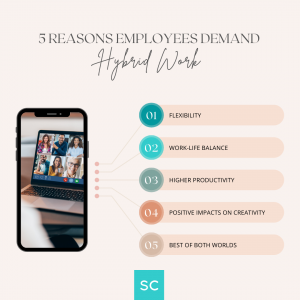How To Lead A Hybrid Team
The future of work is hybrid and if your organization is leaning towards this model, learning how to communicate effectively with your team in a mixed environment is a critical new skill.
 It is no surprise that hybrid work has become a hot demand for many. However, according to Harvard Business Review, hybrid work can create difficult logistical, strategic, and managerial challenges. Some companies are at an advantage as they have implemented forms of hybrid in the past, and others are at a complete disadvantage as their business model required in-person work without the ability to ever work remotely.
It is no surprise that hybrid work has become a hot demand for many. However, according to Harvard Business Review, hybrid work can create difficult logistical, strategic, and managerial challenges. Some companies are at an advantage as they have implemented forms of hybrid in the past, and others are at a complete disadvantage as their business model required in-person work without the ability to ever work remotely.
For example, many businesses that required secure logins have had a hard time reconfiguring their data security in order to allow for remote work. Financial institutions are also at a much higher risk. This is also true of businesses that are paper-heavy. Transporting original documents between home and the office isn’t ideal.
On the flip side, more tech-driven businesses have been able to seamlessly transition to a hybrid work model. If everything is done on a computer with little to no personal data required in the day-to-day – there is much less risk for remote work.
Whatever the situation is for your team and organization, the key to remote success is through clear team communications. With several different hybrid working models at play and the ability for your team to be anywhere in the world at any given time, you will want to make sure that your communication is effective.
1. Clear Communication
We’ve all heard the saying, “It’s crystal clear” and that is exactly how your communication needs to be as you begin leading a team in a hybrid work model.
 So what can you do to ensure that everyone on your team is getting the right information at the right time? There are a couple of things to consider.
So what can you do to ensure that everyone on your team is getting the right information at the right time? There are a couple of things to consider.
- First, make sure everybody knows how what, and when. Nobody ever wants to be surprised.
- Second, gather the information and align the team. Consider the different departments that you will need information from. Then, make sure you are all aligned. Getting aligned could mean that you set up regular weekly meetings, or have a channel where new information is dropped on a daily basis where everyone knows where to go.
- Third, align on execution. This is critical! Again, everyone on your team is expecting to hear from you. If someone on your team hears about a big change and it didn’t come from you, it can cause a lot of confusion and delay. Setting expectations and making sure everyone understands before leaving is key.
Clear communications may seem obvious, but planning a strategy is much more difficult. Following the flow above can help create a process that works.
2. Set Aside Time For Regular Check-Ins
Part of leading a team is listening to your team. It is important to be listening to your team and asking them the right questions. You’ll want to make sure that even though you aren’t seeing each other on a daily basis, you are still engaged with work, its people, and with the company’s objectives.
If your team starts to feel disengaged you may find members of your team leaving to go to other jobs. And while turnover is part of the business life cycle, your goal is to make sure you are providing the best working environment so that employees want to do the best work for you.
There are several ways that you make your check-in’s productive:
- First, schedule it regularly. Be sure that your team knows the date and time and that this particular meeting is specifically to talk about a particular subject.
- Second, support your team members when issues arise. If an issue comes up and you don’t support your team, they will be less likely to come to you with larger more impactful issues.
- Third, always show your appreciation for your team. Using the sandwich method can help you give feedback while also praising your team members. This approach helps all parties engage without being defensive.
- Fourth, express how you would like to see good actions become habits.
- Fifth, try to see any criticism from your team member’s point of view before you react. This may be the most difficult part of receiving feedback, but it is also one of the most important – especially when everyone is adjusting to this new normal.
3. Staying Visible
Whether you are working remotely or in the office, visibility is so important. Your teams need to see you show up to lead and provide reassurance. And, as more organizations embrace a mixture of remote and onsite work, consistent communication from leadership is even more critical. Depending on the hybrid work model that your company has landed upon, you may see some of your team every other day, only on a video, or in-person on occasion.
Because you won’t have the option of simply walking over to someone’s desk for a quick interface, there are several ways you, as the leader, can still remain visible with your team:
- Proactive Communication – not only is communications the glue that keeps companies moving forward, but it is also the first sign that shows when things are starting to crumble.
When there is a breakdown in communications, people often feel left out of the loop and undervalued as they weren’t aware of a major shift.
- Because of this, being proactive in your leadership communications is how you can troubleshoot. In order to be proactive, you must not delay communicating with your team. Do not assume your team knows something because you’ve told one team member. Be sure you make it a point to deliver all important comms to everyone before news breaks.
- Pick a preferred communications channel. Because you won’t be seeing your team on a daily basis, you will want to make sure your team has access to you and they know how to best reach you. If your team feels like you are unreachable, it will make leading them a lot more difficult. So make sure you communicate how and at what times are the best to reach you. If your team can reach you at all hours of the day, be sure to relay that information often as well.
Staying visible while working in a hybrid team comes down to you and your ability to show up as a leader while also working at a distance.
Leading a hybrid team is new for many team leaders, you will face challenges along the way, but the good news is it is totally possible to have a successful company in the new hybrid working world. Remember, the key to success is clear communication and staying visible.
__
Whenever you’re ready, there are 3 ways we can help you:
- Discover your communications style so you know where to start. Over 4,000 people have found theirs here.
- Attend our monthly communication workshop to build communications confidence (new topics: public speaking, advocating for yourself, building credibility, etc) here.
- Get your brand in front of 43k+ people by sponsoring our newsletter or Soulcast Media | LIVE LinkedIn events [contact: hello@soulcastmedia.com]











